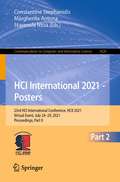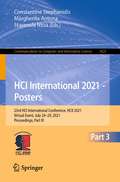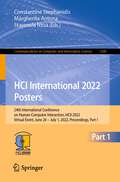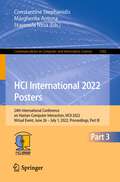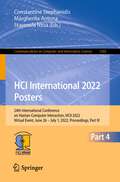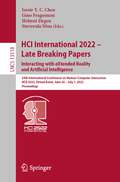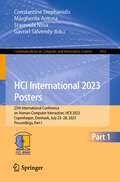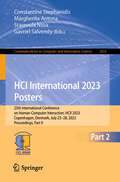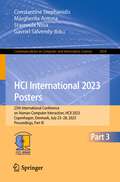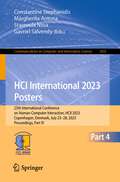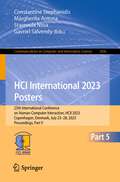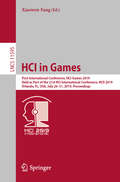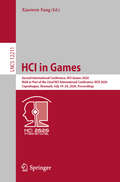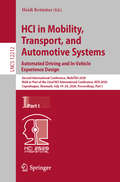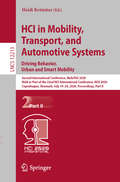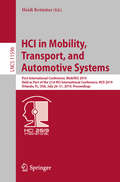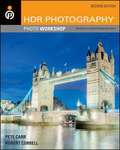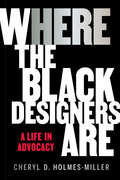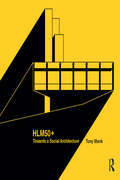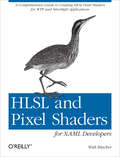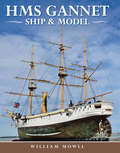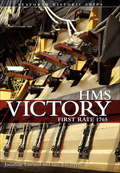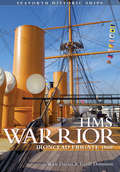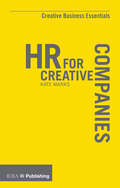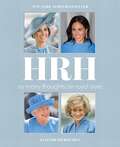- Table View
- List View
HCI International 2021 - Posters: 23rd HCI International Conference, HCII 2021, Virtual Event, July 24–29, 2021, Proceedings, Part II (Communications in Computer and Information Science #1420)
by Margherita Antona Constantine Stephanidis Stavroula NtoaThe three-volume set CCIS 1419, CCIS 1420, and CCIS 1421 contains the extended abstracts of the posters presented during the 23rd International Conference on Human-Computer Interaction, HCII 2021, which was held virtually in July 2021. HCII 2021 received a total of 6326 submissions, of which 1439 papers and 238 posters were accepted for publication in the pre-conference proceedings after a careful reviewing process.The 238 poster papers presented in these three volumes are organized in topical sections as follows: Part I: HCI theory and methods; perceptual, cognitive and psychophisiological aspects of interaction; designing for children; designing for older people; design case studies; dimensions of user experience; information, language, culture and media. Part II: interaction methods and techniques; eye-tracking and facial expressions recognition; human-robot interaction; virtual, augmented and mixed reality; sand privacy issues in HCI; AI and machine learning in HCI. Part III: interacting and learning; interacting and playing; interacting and driving; digital wellbeing, eHealth and mHealth; interacting and shopping; HCI, safety and sustainability; HCI in the time of pandemic.
HCI International 2021 - Posters: 23rd HCI International Conference, HCII 2021, Virtual Event, July 24–29, 2021, Proceedings, Part III (Communications in Computer and Information Science #1421)
by Margherita Antona Constantine Stephanidis Stavroula NtoaThe three-volume set CCIS 1419, CCIS 1420, and CCIS 1421 contains the extended abstracts of the posters presented during the 23rd International Conference on Human-Computer Interaction, HCII 2021, which was held virtually in July 2021. HCII 2021 received a total of 6326 submissions, of which 1439 papers and 238 posters were accepted for publication in the pre-conference proceedings after a careful reviewing process.The 238 poster papers presented in these three volumes are organized in topical sections as follows: Part I: HCI theory and methods; perceptual, cognitive and psychophisiological aspects of interaction; designing for children; designing for older people; design case studies; dimensions of user experience; information, language, culture and media. Part II: interaction methods and techniques; eye-tracking and facial expressions recognition; human-robot interaction; virtual, augmented and mixed reality; sand privacy issues in HCI; AI and machine learning in HCI. Part III: interacting and learning; interacting and playing; interacting and driving; digital wellbeing, eHealth and mHealth; interacting and shopping; HCI, safety and sustainability; HCI in the time of pandemic.
HCI International 2022 Posters: 24th International Conference on Human-Computer Interaction, HCII 2022, Virtual Event, June 26 – July 1, 2022, Proceedings, Part I (Communications in Computer and Information Science #1580)
by Margherita Antona Constantine Stephanidis Stavroula NtoaThe four-volume set CCIS 1580, CCIS 1581, CCIS 1582, and CCIS 1583 contains the extended abstracts of the posters presented during the 24th International Conference on Human-Computer Interaction, HCII 2022, which was held virtually in June - July 2022. The total of 1276 papers and 275 posters included in the 40 HCII 2021 proceedings volumes was carefully reviewed and selected from 5583 submissions.The posters presented in these four volumes are organized in topical sections as follows: Part I: user experience design and evaluation; visual design and visualization; data, information and knowledge; interacting with AI; universal access, accessibility and design for aging. Part II: multimodal and natural interaction; perception, cognition, emotion and psychophysiological monitoring; human motion modelling and monitoring; IoT and intelligent living environments. Part III: learning technologies; HCI, cultural heritage and art; eGovernment and eBusiness; digital commerce and the customer experience; social media and the metaverse. Part IV: virtual and augmented reality; autonomous vehicles and urban mobility; product and robot design; HCI and wellbeing; HCI and cybersecurity.
HCI International 2022 Posters: 24th International Conference on Human-Computer Interaction, HCII 2022, Virtual Event, June 26 – July 1, 2022, Proceedings, Part III (Communications in Computer and Information Science #1582)
by Margherita Antona Constantine Stephanidis Stavroula NtoaThe four-volume set CCIS 1580, CCIS 1581, CCIS 1582, and CCIS 1583 contains the extended abstracts of the posters presented during the 24th International Conference on Human-Computer Interaction, HCII 2022, which was held virtually in June - July 2022. The total of 1276 papers and 275 posters included in the 40 HCII 2021 proceedings volumes was carefully reviewed and selected from 5583 submissions.The posters presented in these four volumes are organized in topical sections as follows: Part I: user experience design and evaluation; visual design and visualization; data, information and knowledge; interacting with AI; universal access, accessibility and design for aging. Part II: multimodal and natural interaction; perception, cognition, emotion and psychophysiological monitoring; human motion modelling and monitoring; IoT and intelligent living environments. Part III: learning technologies; HCI, cultural heritage and art; eGovernment and eBusiness; digital commerce and the customer experience; social media and the metaverse. Part IV: virtual and augmented reality; autonomous vehicles and urban mobility; product and robot design; HCI and wellbeing; HCI and cybersecurity.
HCI International 2022 Posters: 24th International Conference on Human-Computer Interaction, HCII 2022, Virtual Event, June 26 – July 1, 2022, Proceedings, Part IV (Communications in Computer and Information Science #1583)
by Margherita Antona Constantine Stephanidis Stavroula NtoaThe four-volume set CCIS 1580, CCIS 1581, CCIS 1582, and CCIS 1583 contains the extended abstracts of the posters presented during the 24th International Conference on Human-Computer Interaction, HCII 2022, which was held virtually in June - July 2022. The total of 1276 papers and 275 posters included in the 40 HCII 2021 proceedings volumes was carefully reviewed and selected from 5583 submissions.The posters presented in these four volumes are organized in topical sections as follows: Part I: user experience design and evaluation; visual design and visualization; data, information and knowledge; interacting with AI; universal access, accessibility and design for aging. Part II: multimodal and natural interaction; perception, cognition, emotion and psychophysiological monitoring; human motion modelling and monitoring; IoT and intelligent living environments. Part III: learning technologies; HCI, cultural heritage and art; eGovernment and eBusiness; digital commerce and the customer experience; social media and the metaverse. Part IV: virtual and augmented reality; autonomous vehicles and urban mobility; product and robot design; HCI and wellbeing; HCI and cybersecurity.
HCI International 2022 – Late Breaking Papers: 24th International Conference on Human-Computer Interaction, HCII 2022, Virtual Event, June 26 – July 1, 2022, Proceedings (Lecture Notes in Computer Science #13518)
by Gino Fragomeni Jessie Y. C. Chen Helmut Degen Stavroula NtoaThis proceedings LNCS 13518 constitutes the refereed proceedings of the 24th International Conference on Human-Computer Interaction, HCII 2022, which was held virtually as part of the 24th International Conference, HCII 2022, in June/July 2022. HCII 2022 received a total of 5583 submissions from academia, research institutes, industry, and governmental agencies from 88 countries submitted contributions, and 1276 papers and 275 posters were included in the proceedings that were published just before the start of the conference. Additionally, 296 papers and 181 posters are included in the volumes of the proceedings published after the conference, as “Late Breaking Work” (papers and posters). The contributions thoroughly cover the entire field of human-computer interaction, addressing major advances in knowledge and effective use of computers in a variety of application areas.
HCI International 2023 Posters: 25th International Conference on Human-Computer Interaction, HCII 2023, Copenhagen, Denmark, July 23–28, 2023, Proceedings, Part I (Communications in Computer and Information Science #1832)
by Gavriel Salvendy Margherita Antona Constantine Stephanidis Stavroula NtoaThe five-volume set CCIS 1832-1836 contains the extended abstracts of the posters presented during the 25th International Conference on Human-Computer Interaction, HCII 2023, which was held as a hybrid event in Copenhagen, Denmark, in July 2023.The total of 1578 papers and 396 posters included in the 47 HCII 2023 proceedings volumes were carefully reviewed and selected from the 7472 contributions.The posters presented in these five volumes are organized in topical sections as follows: Part I: HCI Design: Theoretical Approaches, Methods and Case Studies; Multimodality and Novel Interaction Techniques and Devices; Perception and Cognition in Interaction; Ethics, Transparency and Trust in HCI; User Experience and Technology Acceptance Studies.Part II: Supporting Health, Psychological Wellbeing, and Fitness; Design for All, Accessibility and Rehabilitation Technologies; Interactive Technologies for the Aging Population.Part III: Interacting with Data, Information and Knowledge; Learning and Training Technologies; Interacting with Cultural Heritage and Art.Part IV: Social Media: Design, User Experiences and Content Analysis; Advances in eGovernment Services; eCommerce, Mobile Commerce and Digital Marketing: Design and Customer Behavior; Designing and Developing Intelligent Green Environments; (Smart) Product Design.Part V: Driving Support and Experiences in Automated Vehicles; eXtended Reality: Design, Interaction Techniques, User Experience and Novel Applications; Applications of AI Technologies in HCI.
HCI International 2023 Posters: 25th International Conference on Human-Computer Interaction, HCII 2023, Copenhagen, Denmark, July 23–28, 2023, Proceedings, Part II (Communications in Computer and Information Science #1833)
by Gavriel Salvendy Margherita Antona Constantine Stephanidis Stavroula NtoaThe five-volume set CCIS 1832-1836 contains the extended abstracts of the posters presented during the 25th International Conference on Human-Computer Interaction, HCII 2023, which was held as a hybrid event in Copenhagen, Denmark, in July 2023.The total of 1578 papers and 396 posters included in the 47 HCII 2023 proceedings volumes were carefully reviewed and selected from the 7472 contributions.The posters presented in these five volumes are organized in topical sections as follows: Part I: HCI Design: Theoretical Approaches, Methods and Case Studies; Multimodality and Novel Interaction Techniques and Devices; Perception and Cognition in Interaction; Ethics, Transparency and Trust in HCI; User Experience and Technology Acceptance Studies.Part II: Supporting Health, Psychological Wellbeing, and Fitness; Design for All, Accessibility and Rehabilitation Technologies; Interactive Technologies for the Aging Population.Part III: Interacting with Data, Information and Knowledge; Learning and Training Technologies; Interacting with Cultural Heritage and Art.Part IV: Social Media: Design, User Experiences and Content Analysis; Advances in eGovernment Services; eCommerce, Mobile Commerce and Digital Marketing: Design and Customer Behavior; Designing and Developing Intelligent Green Environments; (Smart) Product Design.Part V: Driving Support and Experiences in Automated Vehicles; eXtended Reality: Design, Interaction Techniques, User Experience and Novel Applications; Applications of AI Technologies in HCI.
HCI International 2023 Posters: 25th International Conference on Human-Computer Interaction, HCII 2023, Copenhagen, Denmark, July 23–28, 2023, Proceedings, Part III (Communications in Computer and Information Science #1834)
by Gavriel Salvendy Margherita Antona Constantine Stephanidis Stavroula NtoaThe five-volume set CCIS 1832-1836 contains the extended abstracts of the posters presented during the 25th International Conference on Human-Computer Interaction, HCII 2023, which was held as a hybrid event in Copenhagen, Denmark, in July 2023.The total of 1578 papers and 396 posters included in the 47 HCII 2023 proceedings volumes were carefully reviewed and selected from the 7472 contributions.The posters presented in these five volumes are organized in topical sections as follows: Part I: HCI Design: Theoretical Approaches, Methods and Case Studies; Multimodality and Novel Interaction Techniques and Devices; Perception and Cognition in Interaction; Ethics, Transparency and Trust in HCI; User Experience and Technology Acceptance Studies.Part II: Supporting Health, Psychological Wellbeing, and Fitness; Design for All, Accessibility and Rehabilitation Technologies; Interactive Technologies for the Aging Population.Part III: Interacting with Data, Information and Knowledge; Learning and Training Technologies; Interacting with Cultural Heritage and Art.Part IV: Social Media: Design, User Experiences and Content Analysis; Advances in eGovernment Services; eCommerce, Mobile Commerce and Digital Marketing: Design and Customer Behavior; Designing and Developing Intelligent Green Environments; (Smart) Product Design.Part V: Driving Support and Experiences in Automated Vehicles; eXtended Reality: Design, Interaction Techniques, User Experience and Novel Applications; Applications of AI Technologies in HCI.
HCI International 2023 Posters: 25th International Conference on Human-Computer Interaction, HCII 2023, Copenhagen, Denmark, July 23–28, 2023, Proceedings, Part IV (Communications in Computer and Information Science #1835)
by Gavriel Salvendy Margherita Antona Constantine Stephanidis Stavroula NtoaThe five-volume set CCIS 1832-1836 contains the extended abstracts of the posters presented during the 25th International Conference on Human-Computer Interaction, HCII 2023, which was held as a hybrid event in Copenhagen, Denmark, in July 2023.The total of 1578 papers and 396 posters included in the 47 HCII 2023 proceedings volumes were carefully reviewed and selected from the 7472 contributions.The posters presented in these five volumes are organized in topical sections as follows: Part I: HCI Design: Theoretical Approaches, Methods and Case Studies; Multimodality and Novel Interaction Techniques and Devices; Perception and Cognition in Interaction; Ethics, Transparency and Trust in HCI; User Experience and Technology Acceptance Studies.Part II: Supporting Health, Psychological Wellbeing, and Fitness; Design for All, Accessibility and Rehabilitation Technologies; Interactive Technologies for the Aging Population.Part III: Interacting with Data, Information and Knowledge; Learning and Training Technologies; Interacting with Cultural Heritage and Art.Part IV: Social Media: Design, User Experiences and Content Analysis; Advances in eGovernment Services; eCommerce, Mobile Commerce and Digital Marketing: Design and Customer Behavior; Designing and Developing Intelligent Green Environments; (Smart) Product Design.Part V: Driving Support and Experiences in Automated Vehicles; eXtended Reality: Design, Interaction Techniques, User Experience and Novel Applications; Applications of AI Technologies in HCI.
HCI International 2023 Posters: 25th International Conference on Human-Computer Interaction, HCII 2023, Copenhagen, Denmark, July 23–28, 2023, Proceedings, Part V (Communications in Computer and Information Science #1836)
by Gavriel Salvendy Margherita Antona Constantine Stephanidis Stavroula NtoaThe five-volume set CCIS 1832-1836 contains the extended abstracts of the posters presented during the 25th International Conference on Human-Computer Interaction, HCII 2023, which was held as a hybrid event in Copenhagen, Denmark, in July 2023.The total of 1578 papers and 396 posters included in the 47 HCII 2023 proceedings volumes were carefully reviewed and selected from the 7472 contributions.The posters presented in these five volumes are organized in topical sections as follows: Part I: HCI Design: Theoretical Approaches, Methods and Case Studies; Multimodality and Novel Interaction Techniques and Devices; Perception and Cognition in Interaction; Ethics, Transparency and Trust in HCI; User Experience and Technology Acceptance Studies.Part II: Supporting Health, Psychological Wellbeing, and Fitness; Design for All, Accessibility and Rehabilitation Technologies; Interactive Technologies for the Aging Population.Part III: Interacting with Data, Information and Knowledge; Learning and Training Technologies; Interacting with Cultural Heritage and Art.Part IV: Social Media: Design, User Experiences and Content Analysis; Advances in eGovernment Services; eCommerce, Mobile Commerce and Digital Marketing: Design and Customer Behavior; Designing and Developing Intelligent Green Environments; (Smart) Product Design.Part V: Driving Support and Experiences in Automated Vehicles; eXtended Reality: Design, Interaction Techniques, User Experience and Novel Applications; Applications of AI Technologies in HCI.
HCI in Games: First International Conference, HCI-Games 2019, Held as Part of the 21st HCI International Conference, HCII 2019, Orlando, FL, USA, July 26–31, 2019, Proceedings (Lecture Notes in Computer Science #11595)
by Xiaowen FangThis book constitutes the refereed proceedings of the First International Conference on HCI in Games, HCI-Games 2019, held in July 2019 as part of HCI International 2019 in Orlando, FL, USA. HCII 2019 received a total of 5029 submissions, of which 1275 papers and 209 posters were accepted for publication after a careful reviewing process. The 34 papers presented in this volume are organized in topical sections named: Game Design; Gaming Experience; Serious Games; and Gamification.
HCI in Games: Second International Conference, HCI-Games 2020, Held as Part of the 22nd HCI International Conference, HCII 2020, Copenhagen, Denmark, July 19–24, 2020, Proceedings (Lecture Notes in Computer Science #12211)
by Xiaowen FangThis book constitutes the refereed proceedings of the Second International Conference on HCI in Games, HCI-Games 2020, held in July 2020 as part of HCI International 2020 in Copenhagen, Denmark.* HCII 2020 received a total of 6326 submissions, of which 1439 papers and 238 posters were accepted for publication after a careful reviewing process. The 38 papers presented in this volume are organized in topical sections named: designing games and gamified interactions; user engagement and game impact; and serious games. *The conference was held virtually due to the COVID-19 pandemic.
HCI in Mobility, Transport, and Automotive Systems. Automated Driving and In-Vehicle Experience Design: Second International Conference, MobiTAS 2020, Held as Part of the 22nd HCI International Conference, HCII 2020, Copenhagen, Denmark, July 19–24, 2020, Proceedings, Part I (Lecture Notes in Computer Science #12212)
by Heidi KrömkerThis two-volume set LNCS 12212 and 12213 constitutes the refereed proceedings of the Second International Conference on HCI in Mobility, Transport, and Automotive Systems, MobiTAS 2020, held as part of the 22nd International Conference on Human-Computer Interaction, HCII 2020, in Copenhagen, Denmark, in July, 2020.* A total of 1439 full papers and 238 posters have been carefully reviewed and accepted for publication in HCII 2020. The papers cover the entire field of human-computer interaction, addressing major advances in knowledge and effective use of computers in a variety of application areas. MobiTAS 2020 includes a total of 59 papers and they are organized in the following topical sections: Part I, Automated Driving and In-Vehicle Experience Design: UX topics in automated driving, and designing in-vehicle experiences.Part II, Driving Behavior, Urban and Smart Mobility: studies on driving behavior, and urban and smart mobility. *The conference was held virtually due to the COVID-19 pandemic.
HCI in Mobility, Transport, and Automotive Systems. Driving Behavior, Urban and Smart Mobility: Second International Conference, MobiTAS 2020, Held as Part of the 22nd HCI International Conference, HCII 2020, Copenhagen, Denmark, July 19–24, 2020, Proceedings, Part II (Lecture Notes in Computer Science #12213)
by Heidi KrömkerThis two-volume set LNCS 12212 and 12213 constitutes the refereed proceedings of the Second International Conference on HCI in Mobility, Transport, and Automotive Systems, MobiTAS 2020, held as part of the 22nd International Conference on Human-Computer Interaction, HCII 2020, in Copenhagen, Denmark, in July, 2020.* A total of 1439 full papers and 238 posters have been carefully reviewed and accepted for publication in HCII 2020. The papers cover the entire field of human-computer interaction, addressing major advances in knowledge and effective use of computers in a variety of application areas. MobiTAS 2020 includes a total of 59 papers and they are organized in the following topical sections: Part I, Automated Driving and In-Vehicle Experience Design: UX topics in automated driving, and designing in-vehicle experiences.Part II, Driving Behavior, Urban and Smart Mobility: studies on driving behavior, and urban and smart mobility. *The conference was held virtually due to the COVID-19 pandemic.
HCI in Mobility, Transport, and Automotive Systems: First International Conference, MobiTAS 2019, Held as Part of the 21st HCI International Conference, HCII 2019, Orlando, FL, USA, July 26-31, 2019, Proceedings (Lecture Notes in Computer Science #11596)
by Heidi KrömkerThis book constitutes the refereed proceedings of the First International Conference on HCI in Mobility, Transport, and Automotive Systems, MobiTAS 2019, held as part of the 21st International Conference on Human-Computer Interaction, HCII 2019, in Orlando, FL, USA in July, 2019. The 1274 full papers and 209 posters presented at the HCII 2019 conferences were carefully reviewed and selected from 5029 submissions. The papers cover the entire field of human-computer interaction, addressing major advances in knowledge and effective use of computers in a variety of application areas. The papers in this volume are organized in the following topical sections: interaction in autonomous and semiautonomous vehicles; driving experience; and mobility and transport.
HDR Photography Photo Workshop
by Peter Carr Robert CorrellLearn the intricacies of High Dynamic Range photography from experts and get feedback on your workHigh Dynamic Range (HDR) photography offers a new range of creative possibilities to the photographer who is skilled in the technique. HDR requires specific camera skills as well as the use of specialized software, and the photographers who wrote this book are experts in both. They explain the process of shooting the same subject at different exposures, combining those shots into a single HDR image, fine-tuning brightness and contrast, minimizing noise, layering images, and more, including creative techniques with Photoshop and Lightroom.You can submit your HDR images for feedback at photoworkshop.com.High Dynamic Range (HDR) photography offers creative possibilities through specific camera and software techniques that produce highly detailed and imaginative imagesTwo professional photographers team up to provide expert instruction in HDR camera and software techniques for those new to HDRCovers the latest software and concepts, a comprehensive exploration of HDR basics, various techniques for shooting and merging images, and creative tricks with Photoshop and LightroomLavishly illustrated with new examples and full of suggestions for developing a personal HDR styleStudents can upload their own images for feedback at photoworkshop.comAny photographer who is new to HDR will find this guide loaded with helpful instructions and encouraging advice.
HERE: Where the Black Designers Are
by Cheryl D. Holmes-MillerCelebrated designer, writer, activist, and educator Cheryl D. Holmes-Miller's memoir of a life in advocacy and her journey to answer the question "Where are the Black designers?"Cheryl D. Holmes-Miller is one of the design field's most respected figures. She is legendary for her decades of scholarship and activism and is known as a touchstone and conscience for the design profession. This long-awaited book documents the history of the question she has been asking for decades: “Where are the Black designers?” along with related questions that are urgent to the design profession: Where did they originate? Where have they been? Why haven't they been represented in design histories and canons? Holmes-Miller traces her development as a designer and leader, beginning with her own family and its rich multiethnic history. She narrates her experiences as a design student at Rhode Island School of Design, Maryland Institute College of Art, and Pratt, leading up to her oft-cited Pratt thesis examining barriers to success for Black designers. Holmes-Miller describes the work of her eponymous studio for noted clients that included NASA, Time Inc., and the nascent Black Entertainment Television, as well as the story of her later critiques of the industry in the design press, most notably in Print magazine. Miller also recounts the parallel history of collective efforts by fellow scholars and advocates over the past fifty years to identify and celebrate Black designers. Enhanced with a foreword by Crystal Williams, president of Rhode Island School of Design, award-winning poet, and noted advocate for equity and justice in the fields of art and education, HERE is part memoir, part investigation, and part urgent call for justice and recognition for Black designers, making it an invaluable resource for graphic design professionals, teachers, and students.
HLM50+ Towards a Social Architecture
by Tony MonkSince its sudden and dramatic formation upon winning the competition to design Paisley Civic Centre in 1963, Hutchison, Locke and Monk (HLM Architects) has consistently served and adapted to the changing requirements of Britain’s welfare state, and has instinctively dedicated its professional services to community architecture. Conceived from the perspective of founding partner Tony Monk, this book reveals the inside story of how the partnership has grown over 50 years to become a leading UK national practice. It sets out the early influences and progressive design philosophy of HLM Architects and analyses how they developed their design ethos from late-modern through contextual post-modern architectural styles by the early 1980s, and then matured into producing its own contemporary designs, explaining why these changes took place over that period. As well as reflecting the transformations in the social and political landscapes and in aesthetic approaches, it also inevitably records the changing social history of the architectural profession from labour-intensive manual presentations using drafting pens and drawing boards, through to the slick mass-produced computer modelling that accompanied the digital revolution, and the fundamental adjustments needed to meet the realities of managing an efficient modern commercial business. Working with the HLM Board, the authoritative contributors are Directors who have used their knowledge and experience in responding to government legislation with innovative architectural solutions in their specialist fields. HLM Chairman Christopher Liddle is a leading exponent of defence and custodial procurement, alongside Caroline Buckingham in education and Leslie Welch in healthcare. Their award winning projects now help formulate current policy. The critical Introduction by Dr Edward Denison re-examines the practice’s philosophy and contribution to the evolving welfare state during the second half of the twentieth century. The conclusion is a perceptive assessment of the future direction of the architectural profession and a statement of HLM’s continuing commitment to improving our society. The complex relationships described shed new light on previous architectural theories and, in doing so, this book adds to the knowledge of post-war British architecture.
HLSL and Pixel Shaders for XAML Developers: A Comprehensive Guide to Creating HLSL Pixel Shaders for WPF and Silverlight Applications
by Walt RitscherPixel shaders are some of the more powerful graphic tools available for XAML programmers, but shader development bears little resemblance to traditional .NET programming. With this hands-on book, you’ll not only discover how to use existing shaders in your Windows Presentation Foundation (WPF) and Silverlight applications, you’ll also learn how create your own effects with XAML and Microsoft’s HLSL shading language.In the process, you’ll write, compile, and test custom XAML shaders with the Shazzam Shader Editor, a free utility developed by author Walt Ritscher. The book includes XAML and C# sample code, and Shazzam contains all of the sample shaders discussed.Learn how shaders help you extend the GPU’s rendering capabilitiesExplore prevailing shader types, such as color modification, blurring, and spatial transformationGet a quick tour of the shader features, and use pre-built effects on image elements in your applicationExamine the XAML ShaderEffect class to understand how WPF and Silverlight use shadersLearn about the shader-specific tools available in Visual Studio and Expression BlendGet up to speed on HLSL basics and learn how to create a variety of graphics effects
HMS Gannet: Ship & Model
by William MowllHMS Gannet, beautifully restored today at Chatham Historic Dockyard, is a fine example of the small colonial schooners that were built and deployed in the second half of the nineteenth century to police Britains great empire and enforce the peace of Pax Britannica. Launched at Sheerness in 1878 with her white Mediterranean livery and elegant clipper bow, she was the epitome of the colonial gunboat.In this new book by the well-known ship modeller Will Mowll, the design and history of _Gannet_ is outlined before the author takes the reader on a detailed photographic step-by-step exposition of the building of his 1/48 scale model of the ship. A particular feature of the model is the inclusion of a static representation of the 2-cylinder compound steam engine with its three cylindrical boilers. Exquisitely detailed, with even the bunkered coal beautifully modelled, all the machinery is made visible by means of the removable deck. The author has therefore reconstructed a major feature of the ship which is no longer extant on the prototype at Chatham.All the information that a ship modeller might need is included here hull construction and the coppering of the ships bottom, the making of the ships steam propulsion systems, the decks and decking, armament, steering gear, mast and yards and rigging, and even the furniture in the wardroom. No part of the ship is left hidden. Inspiring with the sheer quality of his workmanship, the author has brought beautifully to life another of Britains great museum ships.
HMS Victory: First Rate 1765 (Seaforth Historic Ships)
by Iain Ballantyne Jonathan Eastland&“A first-rate visual guide to the most famous preserved warship on the planet. The imagery has the &‘wow&’ factor . . . a brilliant showcase.&”—Warships International Fleet Review HMS Victory is probably the best-known historic ship in the world. A symbol of the Royal Navy&’s achievements during the great age of sail, she is based in Portsmouth and seen by tens of thousands of visitors each year. In this new series written by experts and containing more than 200 specially commissioned photographs, each title will take the reader on a superbly illustrated tour of the ship, from bow to stern and deck by deck. Significant parts of the vessel for example, the capstan, steering gear, armament, brody stove, cockpit, stern cabins are given detailed coverage both in words and pictures, so that the reader has at hand the most complete visual record and explanation of the ship that exists. In addition, the importance of the ship, both in her own time and now as a museum vessel, is explained, while her design and build, her fighting career and her life prior to restoration and exhibition are all described. No other books offer such superb visual impact and detailed information as the Seaforth Historic Ship Series—a truly groundbreaking concept bringing the ships of our past vividly to life. Nominated for the 2011 Mountbatten Awards &“In a precise and careful treatment, they cover the evolution of naval architecture, maritime warfare, and British strategy that led to the construction of the 100-gun ship-of-the-line . . . A valuable book for students of the age of fighting sail.&”—New York Military Affairs Symposium
HMS Warrior: Ironclad Frigate 1860 (Seaforth Historic Ships)
by Wyn Davies Geoff Dennison&“A well-illustrated tour of the ship as she is today, deck by deck . . . includes a historical introduction looking at the ship and her significance.&”—Ships Monthly HMS Warrior, launched in 1860, was the first iron-hulled, sea-going armored ship, and for many years was the most powerful warship in the world. Rescued a century later from her role as a refueling hulk, she became the object of the most ambitious ship restoration project ever mounted and is now afloat and open to visitors at Portsmouth. As is the case for many historic ships, however, there is a surprising shortage of informative and well-illustrated guides, for reference during a visit or for research by enthusiasts, ship modelers, naval buffs, technical historians or students. This book—second in the Seaforth Historic Ship Series—redresses the gap. Written by experts and containing more than 200 specially commissioned photographs, each title in the series takes the reader on a superbly illustrated tour of the ship, deck by deck. Significant parts of the vessel for example, the steering gear, armament and armor, engine-room and gundeck are given detailed coverage so that the reader has at hand the most complete visual record and explanation of the ship that is at present available. In addition, the importance of the ship, both in her own time and now as a museum vessel, is explained, while her design and build, her service career and her life prior to restoration and exhibition are all described. The Seaforth Historic Ship Series is a truly groundbreaking concept, bringing the ships of our past vividly to life. &“A beautiful publication.&”—Ships in Scale
HR for Creative Companies
by Kate MarksThere is an increasing realisation that small businesses, including architecture practices need to pro-actively engage with HR rather than simply firefighting when something goes wrong. Good HR practices can help with business efficiency and profitability – they provide positive commercial tools that architects and other professionals can use to enhance their creativity whilst simultaneously increasing their commerciality. This book will provide simple, pragmatic and practical advice, anecdotes and template documents for a variety of common situations that arise in the HR employee life-cycle, such as succession planning and staff engagement. Using examples from a range of different architecture practices, readers will learn how these organizations have successfully approached the issue of people management, by implementing tried and tested HR models. For sole and small practices, this easy to digest book shows architects and other design professionals that HR can be a positive, profitable and even pleasurable tool for business success.
HRH: So Many Thoughts on Royal Style
by Elizabeth Holmes**THE INSTANT NEW YORK TIMES BESTSELLER**Veteran style journalist Elizabeth Holmes expands her popular Instagram series, So Many Thoughts, into a nuanced look at the fashion and branding of the four most influential members of the British Royal Family: Queen Elizabeth II; Diana, Princess of Wales; Catherine, The Duchess of Cambridge; and Meghan, The Duchess of Sussex.Kate Middleton and Meghan Markle are global style icons, their every fashion choice chronicled and celebrated. With all eyes on them, the duchesses select clothes that send a message about their values, interests, and priorities. Their thoughtful sartorial strategies follow in the footsteps of Queen Elizabeth II and Diana, Princess of Wales, two towering figures known for using their personal style to great acclaim.With one section devoted to each woman, HRH is a celebration of their stories and their style, pairing hundreds of gorgeous photographs with extensive research. A picture emerges of the British monarchy’s evolution and the power of royal fashion, showing there’s always more than what meets the eye.
